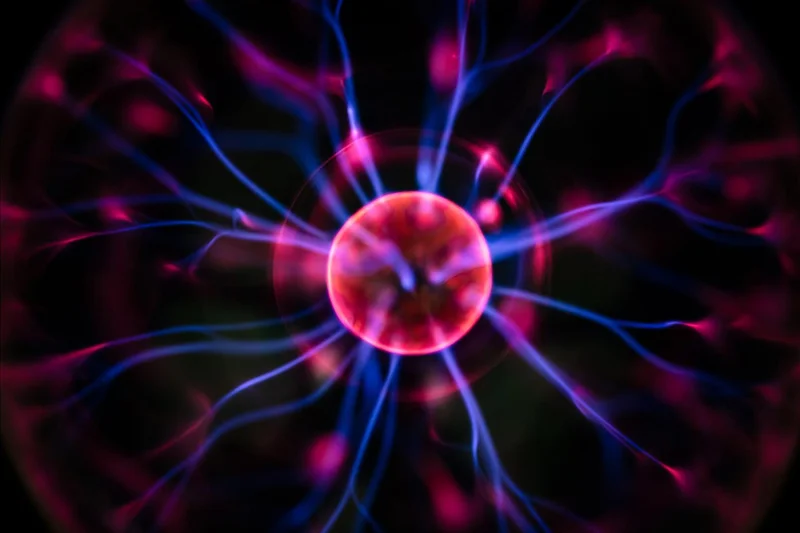The Plasma Industry: What It Is vs. Who Profits From It
From Superheated Gas to Speculative Asset: The Four States of 'Plasma'
The word is plasma. In physics, it’s the fourth state of matter, a superheated, ionized gas that constitutes over 99% of the visible universe. It’s the substance of stars and lightning. On a Tuesday morning in Wyoming, at 12:14 a.m., it was a ribbon of light so intense that one observer, Andrea Cook, described it as an “unholy bright” searchlight tearing across the sky.
This was not an aurora. It was a related, rarer phenomenon called a STEVE—Strong Thermal Emission Velocity Enhancement. Data from NASA satellites confirms the temperature inside this atmospheric river of plasma reaches 5,430 degrees Celsius, flowing at an altitude of 280 miles. It is a tangible, measurable, and profoundly physical event. Eyewitnesses near Casper reported it twisting like a tornado for over 30 minutes. Here, plasma is a force of nature, an object of scientific inquiry whose origins are still not fully understood. It is the baseline reality.
The Unforgiving Physics of Promises
The Engineering Discrepancy
Harnessing this state of matter is a fundamentally difficult engineering problem. Consider Zap Energy’s fusion test platform, Century. The objective is to control and sustain plasma to generate power. The numbers involved are unforgiving. Century drives pulses of up to 500 kiloamperes—roughly 20 times the current of a lightning bolt—into a chamber lined with 2,500 pounds of circulating liquid bismuth to absorb the heat. The company’s CEO, Benj Conway, states it plainly: “Fusion is not just a plasma problem. It’s a systems integration problem.”
Failure in systems integration has immediate, physical consequences. This is precisely what we see in the recent 3M Company correction for its Ranger Blood/Fluid Warming System. The device is designed to warm blood and plasma for transfusions, a critical function to prevent hypothermia in patients. The product was labeled as capable of delivering fluid at 500 mL/min while maintaining a temperature between 33°C and 41°C. However, subsequent testing revealed a significant performance discrepancy.
The unit can only maintain the required temperature at a flow rate of up to 167 mL/min for refrigerated fluids. That’s a 66% reduction in stated capability. The risk is not theoretical; administering under-warmed fluids can lead to serious adverse health consequences (a risk that triggered the FDA's most serious recall classification). The problem isn't the plasma itself; it's the difficulty of the engineering required to manage its thermal properties reliably. In both fusion reactors and medical devices, the physics of plasma are brutal and non-negotiable.

This brings us to the next state of plasma: the biological commodity. For decades, the act of donating plasma has existed in a space between altruism and commerce. A recent agreement in Canada illustrates the increasing complexity of this relationship. Canadian Blood Services, a non-profit, entered a partnership with Grifols, a multinational pharmaceutical company, to increase plasma collection. The initial understanding was that Grifols would produce medications for Canadian patients.
It has since come to light that the arrangement evolved. In February, the agreement was amended to allow Grifols to process byproducts from the donated plasma into albumin, a protein product, for sale on the international market. The non-profit states the revenue offsets its costs, but the donors themselves—the source of the raw material—report feeling surprised by the development. One weekly donor, Peter Johnson, noted his preference for donations to be “maintained in a not-for-profit type of an environment,” believing that to be the intent of the donor. Here, the physical substance of blood plasma begins its abstraction into a financial asset, its value chain extending far beyond the donor’s arm and into global pharmaceutical revenue streams.
html Trading the Ticker, Not the Thermodynamics
The Velocity of Abstraction
The final state of plasma is one of pure, frictionless abstraction. On September 25th, a new cryptocurrency token, Plasma [XPL], was launched. Within three days, its price surged almost 90%—to be more exact, 87.25%—creating a market capitalization of $3.3 billion. The project launched with an initial $2 billion in stablecoin liquidity, a figure meant to signal institutional backing.
On-chain data shows significant whale activity. One entity reportedly realized a profit of $80.15 million through a series of leveraged trades. Retail participation followed, with buy volume hitting nearly $400 million on September 27th, producing a $36.8 million positive delta against sell volume. I’ve analyzed hundreds of new asset launches, and the velocity of capital into an instrument with no discernible underlying function beyond its own trading is always noteworthy.
Unlike the plasma in the sky, in the fusion reactor, or in the human bloodstream, this version has no temperature, no mass, no physical properties. It is a name attached to a ledger entry. Its value is not derived from solving a complex systems integration problem but from narrative, liquidity, and momentum. The challenges are not in thermodynamics but in market timing. The risk is not hypothermia but liquidation. The word “plasma” has been fully decoupled from its physical meaning and is now a brand, a ticker symbol engineered not for thermal stability but for speculative velocity. The journey is complete: from a 5,430-degree celestial ribbon to a name on an exchange, traded by algorithms in air-conditioned data centers.
A Discrepancy in States
The data presents a clear inverse correlation: the more tangible and physically constrained the form of "plasma," the slower and more difficult its progress. The more abstract and detached from physical reality it becomes, the faster the capital moves. The language of science and medicine—precise, cautious, and tied to measurable outcomes—has been appropriated by finance for its narrative value. One system is bound by the laws of physics; the other is bound only by the speed of belief.
Reference article source:
